Design of Wideband Decoupling Antenna Array for 5G Smartphones at N77/N78/N79/WLAN 5 GHz Bands
Abstract
:1. Introduction
2. Design and Evolution of Antenna Systems
2.1. Configuration
2.2. Design Process and Analysis
2.3. Parameter Analysis
3. Performance of the Eight-Element Antenna System
3.1. Eight-Element MIMO Antenna System Prototype
3.1.1. S-Parameters
3.1.2. Total Efficiency, Radiation Efficiency, and Peak Gain
3.1.3. ECC
3.1.4. DG
3.1.5. Radiation Pattern
3.2. Handheld Effects
4. Conclusions
Author Contributions
Funding
Institutional Review Board Statement
Informed Consent Statement
Data Availability Statement
Conflicts of Interest
References
- Dilli, R. Analysis of 5G wireless systems in FR1 and FR2 frequency bands. In Proceedings of the 2020 2nd International Conference on Innovative Mechanisms for Industry Applications (ICIMIA), Bangalore, India, 5–7 March 2020; pp. 767–772. [Google Scholar]
- Sun, L.; Feng, H.; Li, Y.; Zhang, Z. Compact 5G MIMO mobile phone antennas with tightly arranged orthogonal-mode pairs. IEEE Trans. Antennas Propag. 2018, 66, 6364–6369. [Google Scholar] [CrossRef]
- Alibakhshikenari, M.; Babaeian, F.; Virdee, B.S.; Aïssa, S.; Azpilicueta, L.; See, C.H.; Althuwayb, A.A.; Huynen, I.; Abd-Alhameed, R.A.; Falcone, F. A comprehensive survey on “Various decoupling mechanisms with focus on metamaterial and metasurface principles applicable to SAR and MIMO antenna systems”. IEEE Access 2020, 8, 192965–193004. [Google Scholar] [CrossRef]
- Mak, A.C.; Rowell, C.R.; Murch, R.D. Isolation enhancement between two closely packed antennas. IEEE Trans. Antennas Propag. 2008, 56, 3411–3419. [Google Scholar] [CrossRef]
- Li, Z.; Du, Z.; Takahashi, M.; Saito, K.; Ito, K. Reducing mutual coupling of MIMO antennas with parasitic elements for mobile terminals. IEEE Trans. Antennas Propag. 2011, 60, 473–481. [Google Scholar] [CrossRef]
- Tran, H.H.; Nguyen-Trong, N. Performance enhancement of MIMO patch antenna using parasitic elements. IEEE Access 2021, 9, 30011–30016. [Google Scholar] [CrossRef]
- Chiu, C.-Y.; Cheng, C.-H.; Murch, R.D.; Rowell, C.R. Reduction of mutual coupling between closely-packed antenna elements. IEEE Trans. Antennas Propag. 2007, 55, 1732–1738. [Google Scholar] [CrossRef]
- Zhao, X.; Riaz, S. A dual-band frequency reconfigurable MIMO patch-slot antenna based on reconfigurable microstrip feedline. IEEE Access 2018, 6, 41450–41457. [Google Scholar] [CrossRef]
- Jamal, M.Y.; Li, M.; Yeung, K.L. Isolation enhancement of closely packed dual circularly polarized MIMO antenna using hybrid technique. IEEE Access 2020, 8, 11241–11247. [Google Scholar] [CrossRef]
- Wang, Y.; Du, Z. A wideband printed dual-antenna with three neutralization lines for mobile terminals. IEEE Trans. Antennas Propag. 2013, 62, 1495–1500. [Google Scholar] [CrossRef]
- Zhang, S.; Pedersen, G.F. Mutual coupling reduction for UWB MIMO antennas with a wideband neutralization line. IEEE Antennas Wirel. Propag. Lett. 2015, 15, 166–169. [Google Scholar] [CrossRef]
- Liu, R.; An, X.; Zheng, H.; Wang, M.; Gao, Z.; Li, E. Neutralization line decoupling tri-band multiple-input multiple-output antenna design. IEEE Access 2020, 8, 27018–27026. [Google Scholar] [CrossRef]
- Sarrazin, J.; Mahé, Y.; Avrillon, S.; Toutain, S. Investigation on cavity/slot antennas for diversity and MIMO systems: The example of a three-port antenna. IEEE Antennas Wirel. Propag. Lett. 2008, 7, 414–417. [Google Scholar] [CrossRef]
- Kiani, S.H.; Savci, H.S.; Abubakar, H.S.; Parchin, N.O.; Rimli, H.; Hakim, B. Eight Element MIMO Antenna Array With Tri-Band Response for Modern Smartphones. IEEE Access 2023, 11, 44244–44253. [Google Scholar] [CrossRef]
- Chang, L.; Yu, Y.; Wei, K.; Wang, H. Polarization-orthogonal co-frequency dual antenna pair suitable for 5G MIMO smartphone with metallic bezels. IEEE Trans. Antennas Propag. 2019, 67, 5212–5220. [Google Scholar] [CrossRef]
- Wong, K.L.; Chang, H.J.; Li, W.Y. Integrated triple-wideband triple-inverted-F antenna covering 617–960/1710–2690/3300–4200 MHz for 4G/5G communications in the smartphone. Microw. Opt. Technol. Lett. 2018, 60, 2091–2096. [Google Scholar] [CrossRef]
- Sui, J.; Wu, K.-L. Quad-IFA MIMO Antennas Using Self-curing Decoupling Technique. In Proceedings of the 2018 IEEE International Symposium on Antennas and Propagation & USNC/URSI National Radio Science Meeting, Boston, MA, USA, 8–13 July 2018; pp. 1383–1384. [Google Scholar]
- Sui, J.; Dou, Y.; Mei, X.; Wu, K.-L. Self-curing decoupling technique for MIMO antenna arrays in mobile terminals. IEEE Trans. Antennas Propag. 2019, 68, 838–849. [Google Scholar] [CrossRef]
- Chen, S.-C.; Wang, Y.-S.; Chung, S.-J. A decoupling technique for increasing the port isolation between two strongly coupled antennas. IEEE Trans. Antennas Propag. 2008, 56, 3650–3658. [Google Scholar] [CrossRef]
- Sun, L.; Li, Y.; Zhang, Z.; Feng, Z. Wideband 5G MIMO antenna with integrated orthogonal-mode dual-antenna pairs for metal-rimmed smartphones. IEEE Trans. Antennas Propag. 2019, 68, 2494–2503. [Google Scholar] [CrossRef]
- Liu, H.-Y.; Huang, C.-J. Wideband MIMO antenna array design for future mobile devices operating in the 5G NR frequency bands n77/n78/n79 and LTE band 46. IEEE Antennas Wirel. Propag. Lett. 2019, 19, 74–78. [Google Scholar]
- Serghiou, D.; Khalily, M.; Singh, V.; Araghi, A.; Tafazolli, R. Sub-6 GHz dual-band 8 × 8 MIMO antenna for 5G smartphones. IEEE Antennas Wirel. Propag. Lett. 2020, 19, 1546–1550. [Google Scholar] [CrossRef]
- Yu, Z.; Wang, M.; Xie, Y. An improved loop ultra-wideband mimo antenna system for 5G mobile terminals. Prog. Electromagn. Res. Lett. 2020, 93, 99–106. [Google Scholar] [CrossRef]
- Yuan, X.-T.; He, W.; Hong, K.-D.; Han, C.-Z.; Chen, Z.; Yuan, T. Ultra-wideband MIMO antenna system with high element-isolation for 5G smartphone application. IEEE Access 2020, 8, 56281–56289. [Google Scholar] [CrossRef]
- Sun, L.; Li, Y.; Zhang, Z. Wideband integrated quad-element MIMO antennas based on complementary antenna pairs for 5G smartphones. IEEE Trans. Antennas Propag. 2021, 69, 4466–4474. [Google Scholar] [CrossRef]
- Yuan, X.-T.; Chen, Z.; Gu, T.; Yuan, T. A wideband PIFA-pair-based MIMO antenna for 5G smartphones. IEEE Antennas Wirel. Propag. Lett. 2021, 20, 371–375. [Google Scholar] [CrossRef]
- Hei, Y.Q.; He, J.G.; Li, W.T. Wideband decoupled 8-element MIMO antenna for 5G mobile terminal applications. IEEE Antennas Wirel. Propag. Lett. 2021, 20, 1448–1452. [Google Scholar] [CrossRef]
- Sun, L.; Li, Y.; Zhang, Z. Wideband decoupling of integrated slot antenna pairs for 5G smartphones. IEEE Trans. Antennas Propag. 2020, 69, 2386–2391. [Google Scholar] [CrossRef]
- Du, K.; Wang, Y.; Zhang, L.; Hu, Y. Design of Wideband Decoupling Antenna Pairs for 5G Portable Devices at N77/N78/N79 Bands. Micromachines 2022, 13, 1964. [Google Scholar] [CrossRef]
- Ren, A.; Yu, H.; Yang, L.; Huang, Z.; Zhang, Z.; Liu, Y. A Broadband MIMO Antenna Based on Multi-Modes for 5G Smartphone Applications. IEEE Antennas Wirel. Propag. Lett. 2023, 22, 1642–1646. [Google Scholar] [CrossRef]
- Desai, A.; Palandoken, M.; Kulkarni, J.; Byun, G.; Nguyen, T.K. Wideband flexible/transparent connected-ground MIMO antennas for sub-6 GHz 5G and WLAN applications. IEEE Access 2021, 9, 147003–147015. [Google Scholar] [CrossRef]
- Singh, H.; Sohi, B.S.; Gupta, A. Designing and performance evaluation of metamaterial inspired antenna for 4G and 5G applications. Int. J. Electron. 2021, 108, 1035–1057. [Google Scholar] [CrossRef]
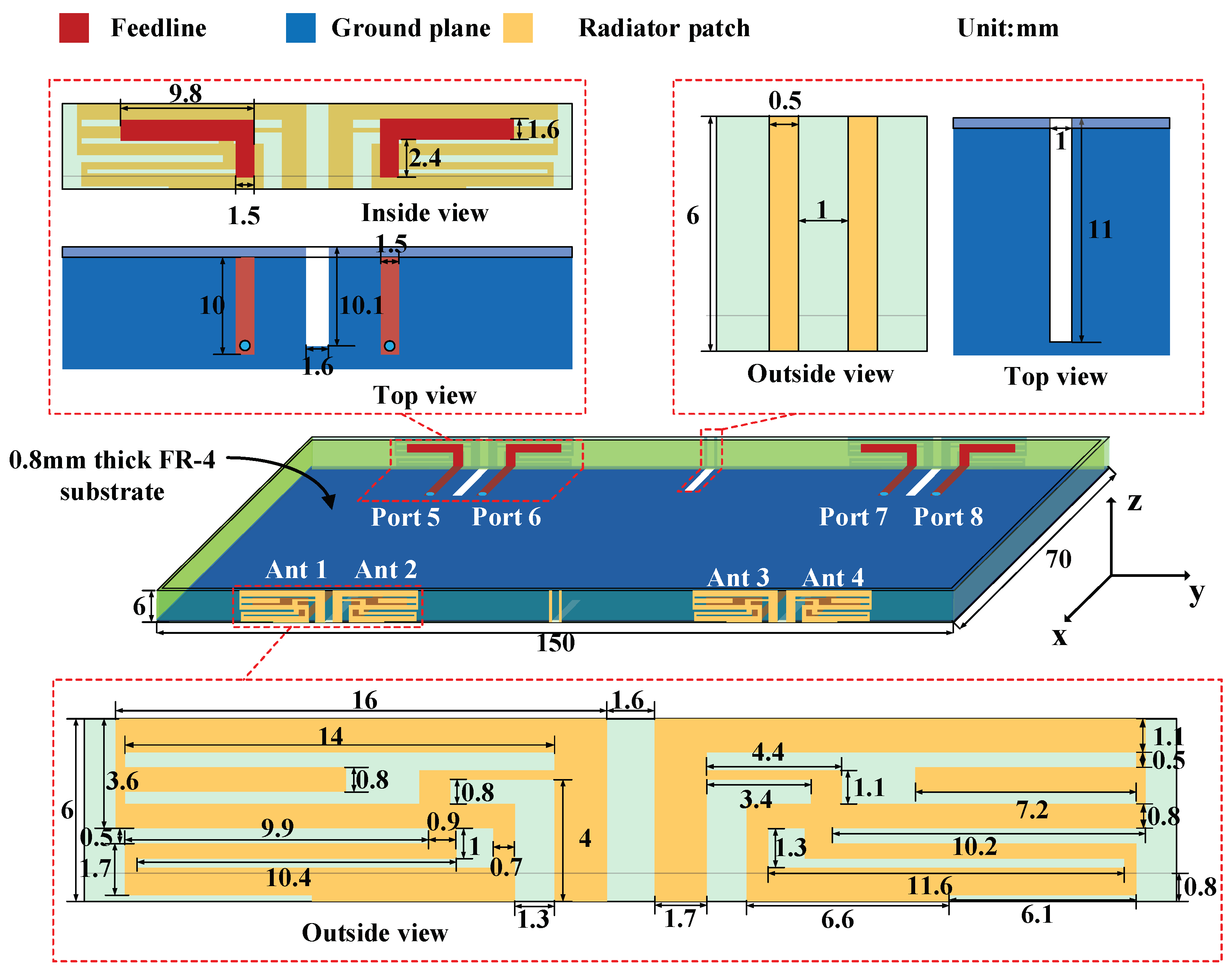

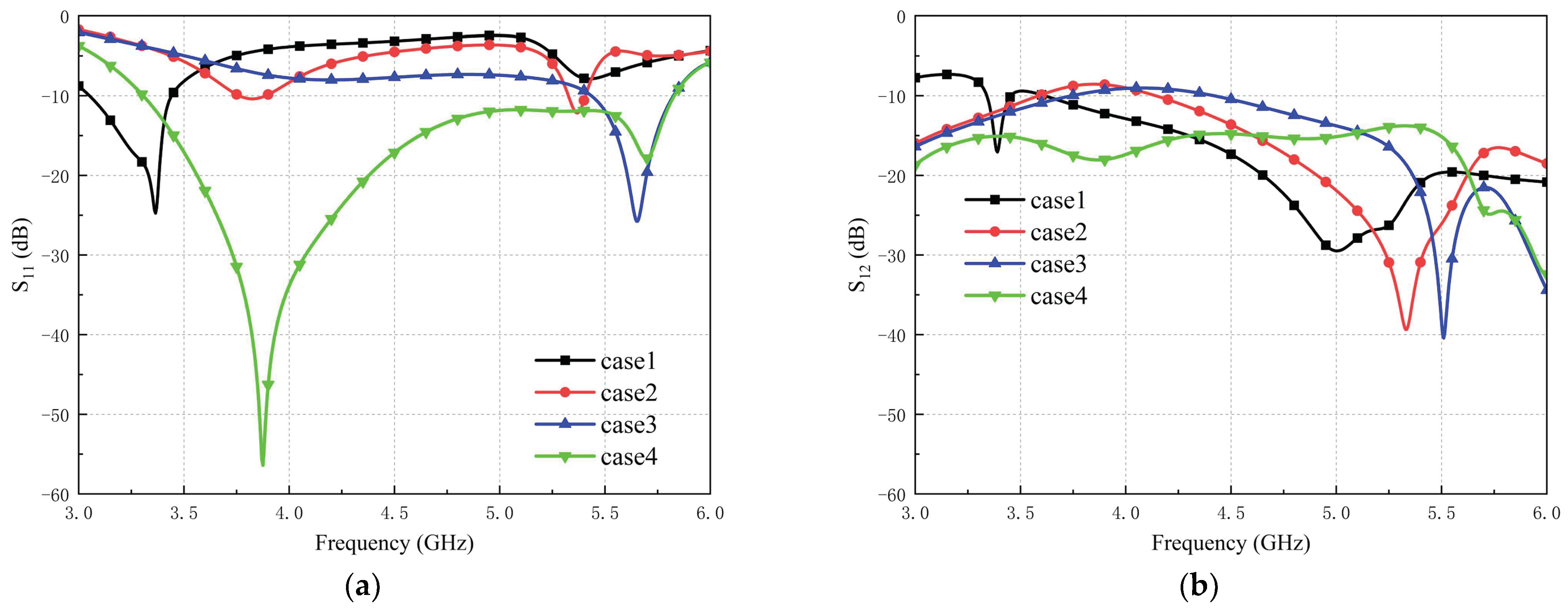
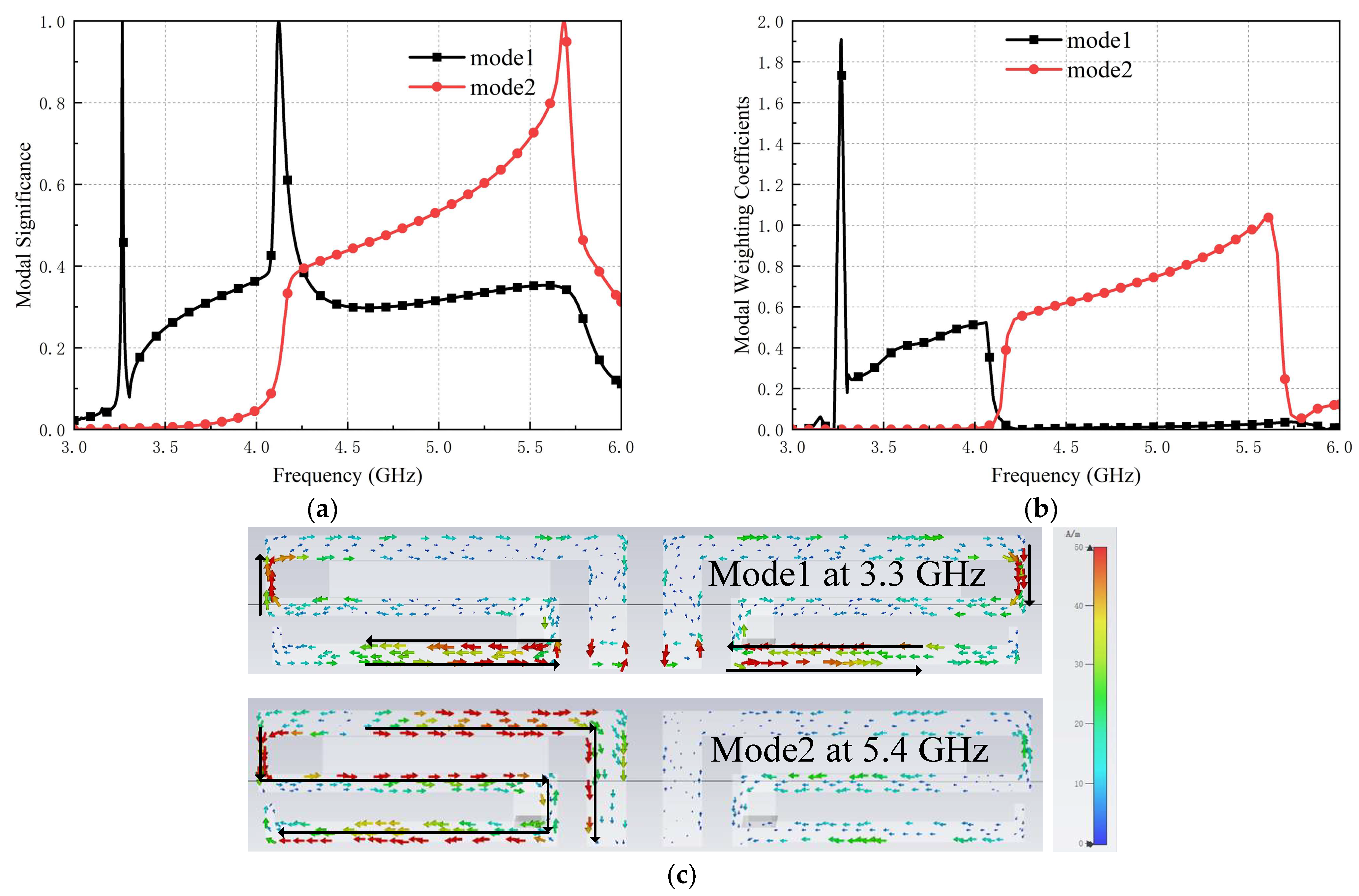
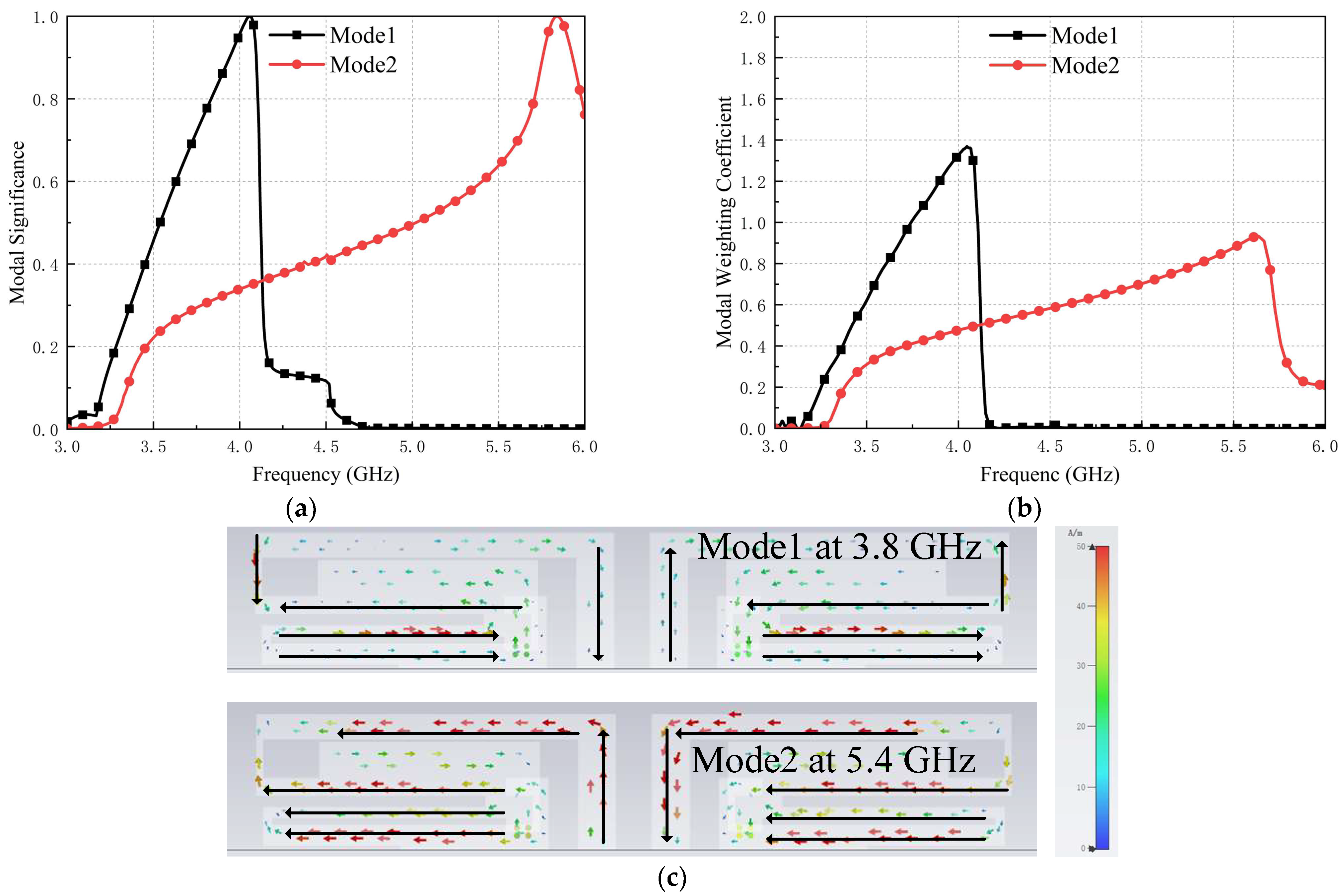
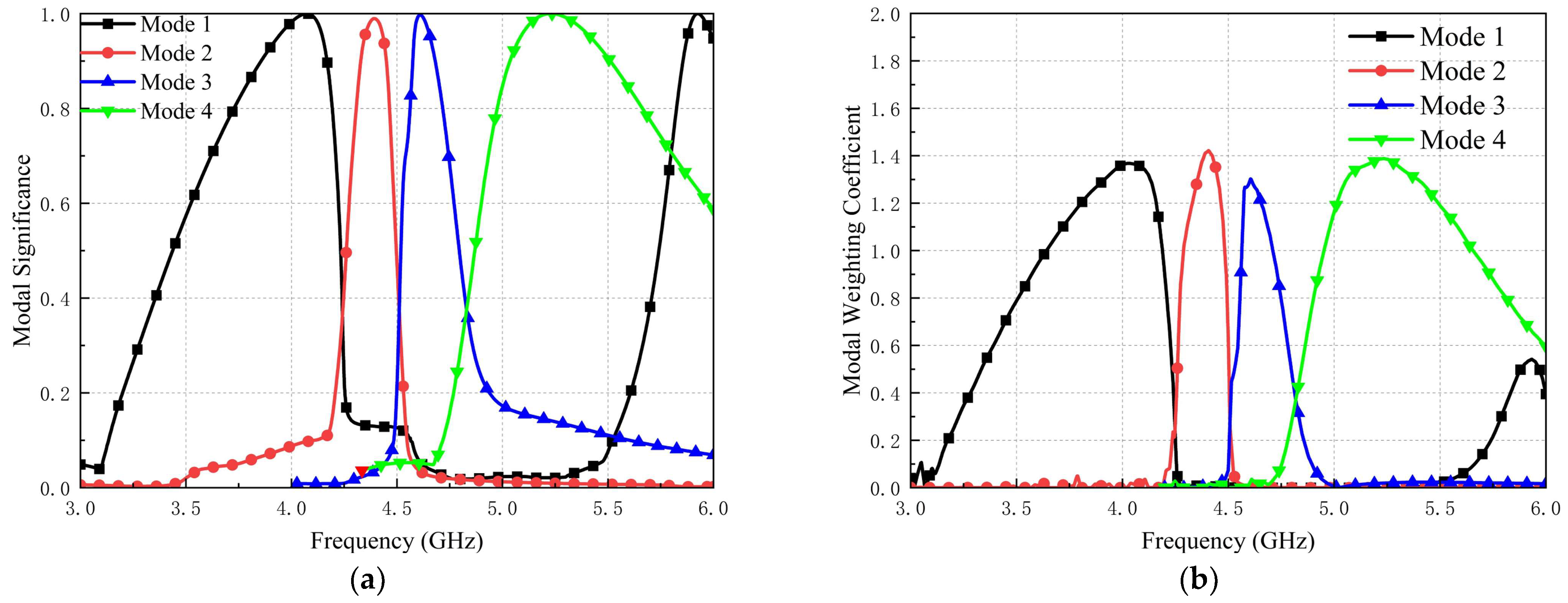
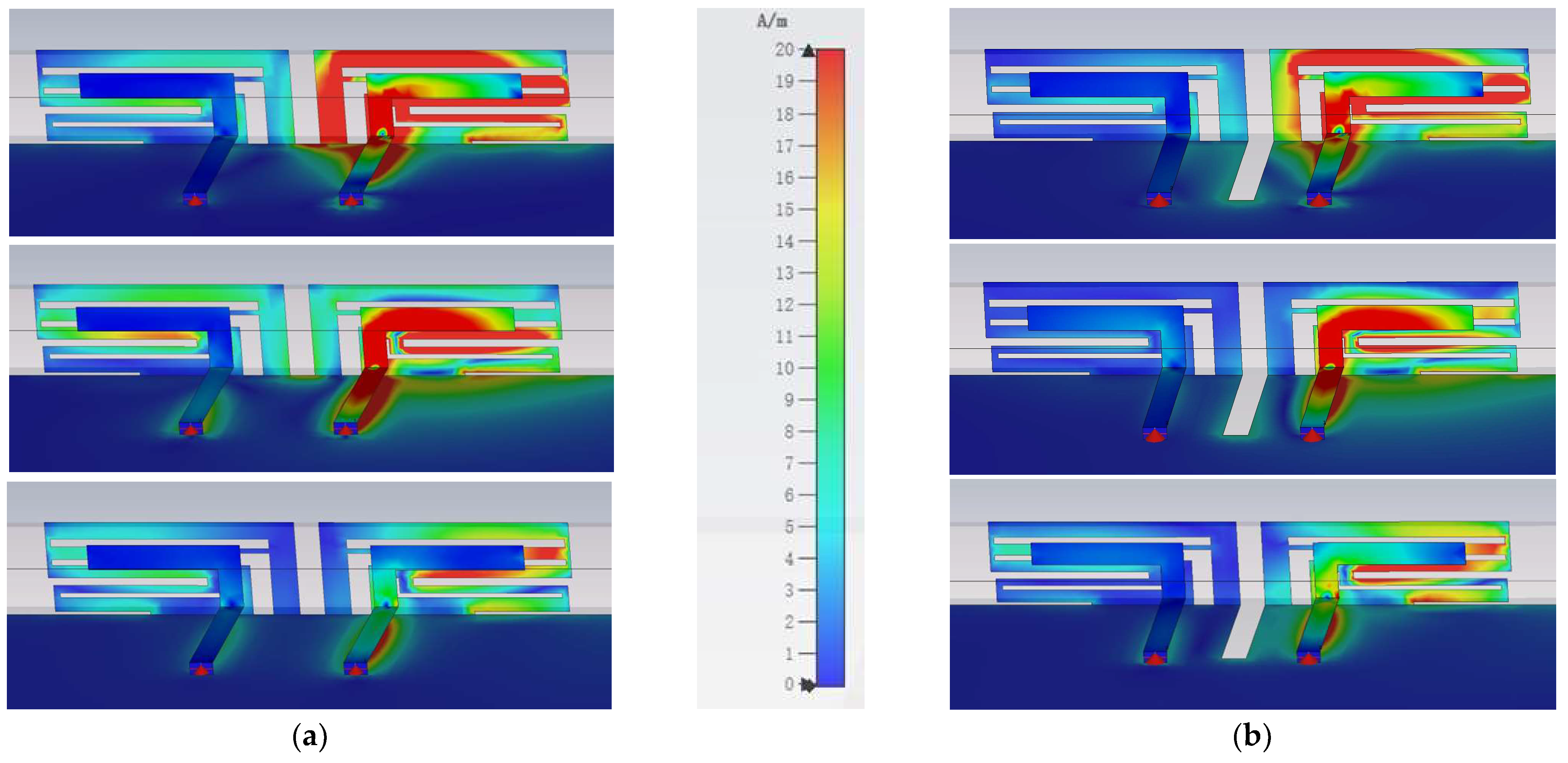


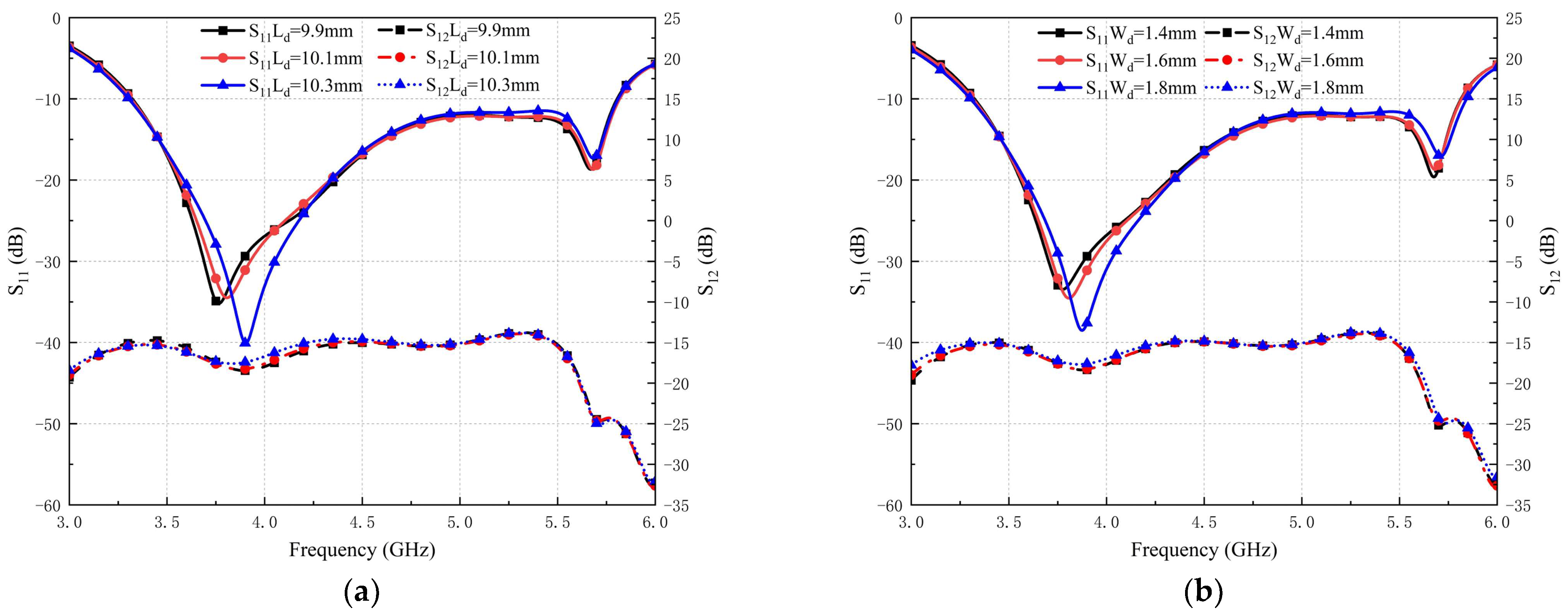
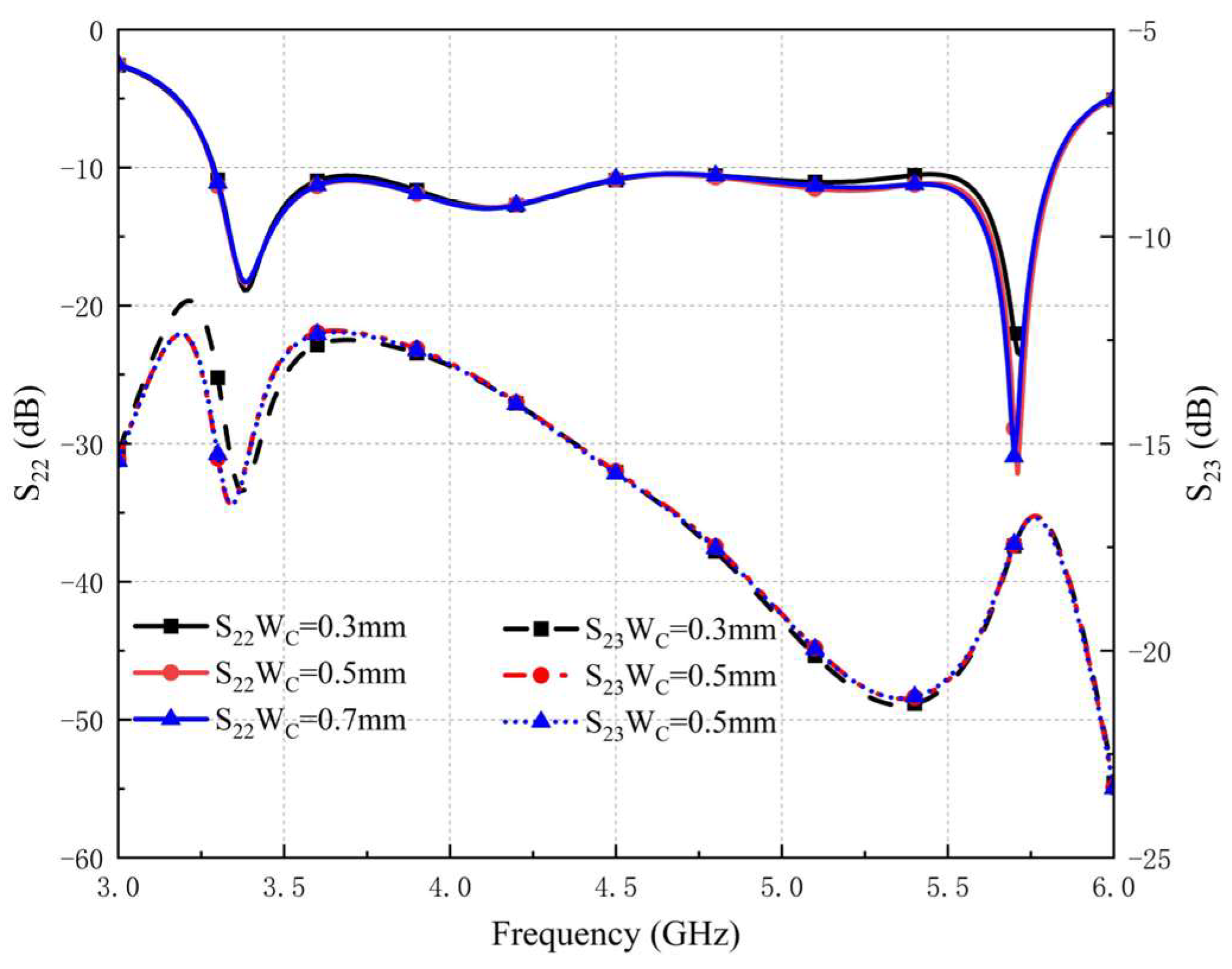
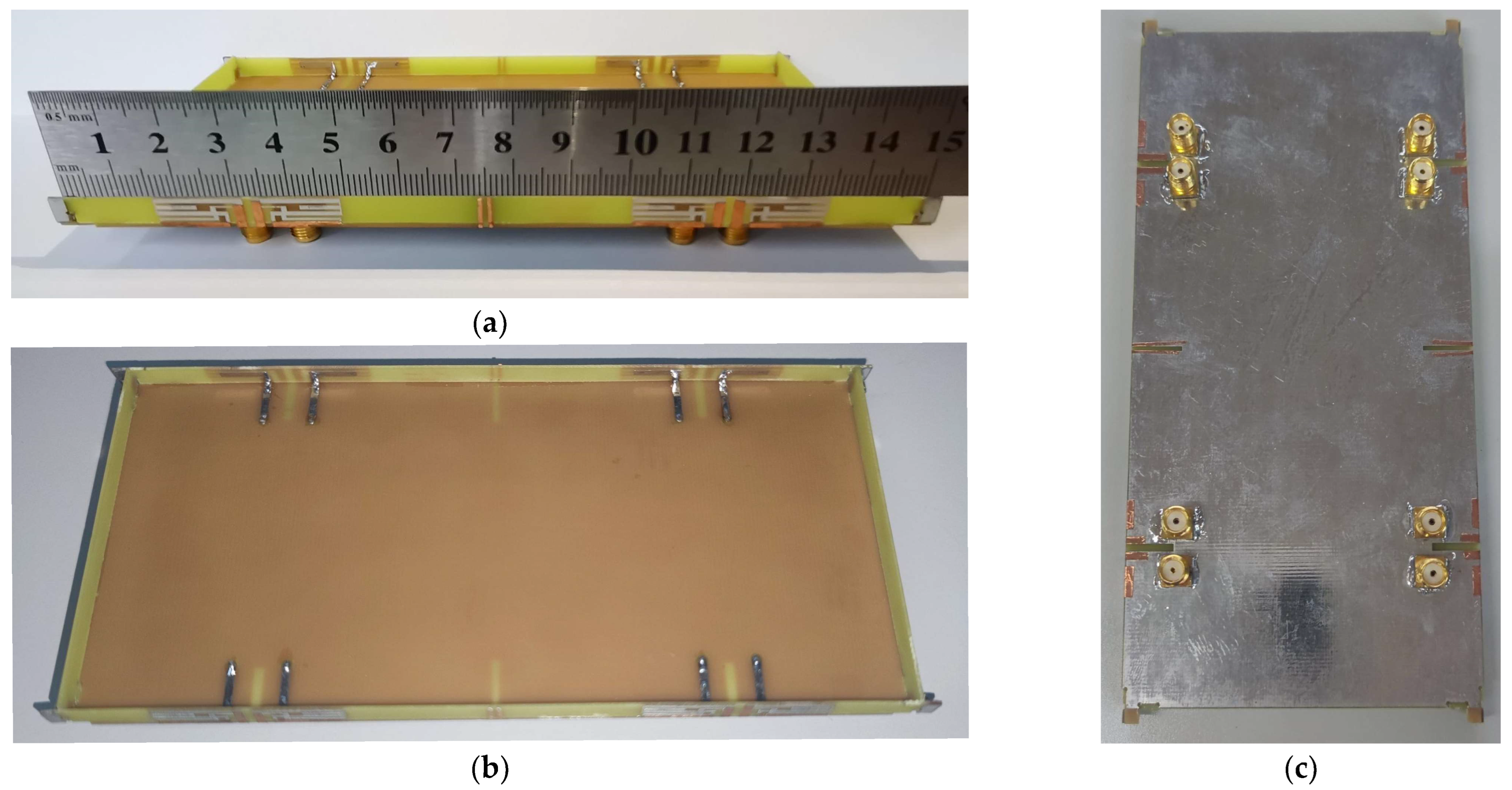
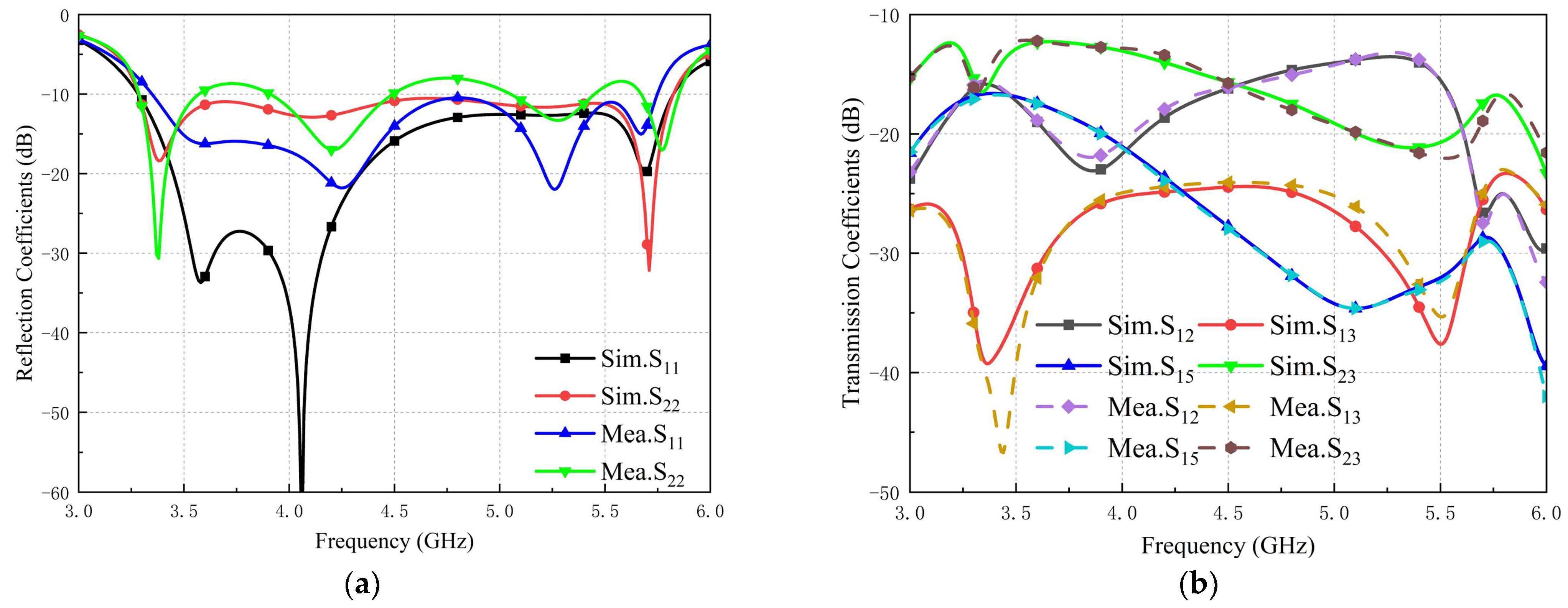
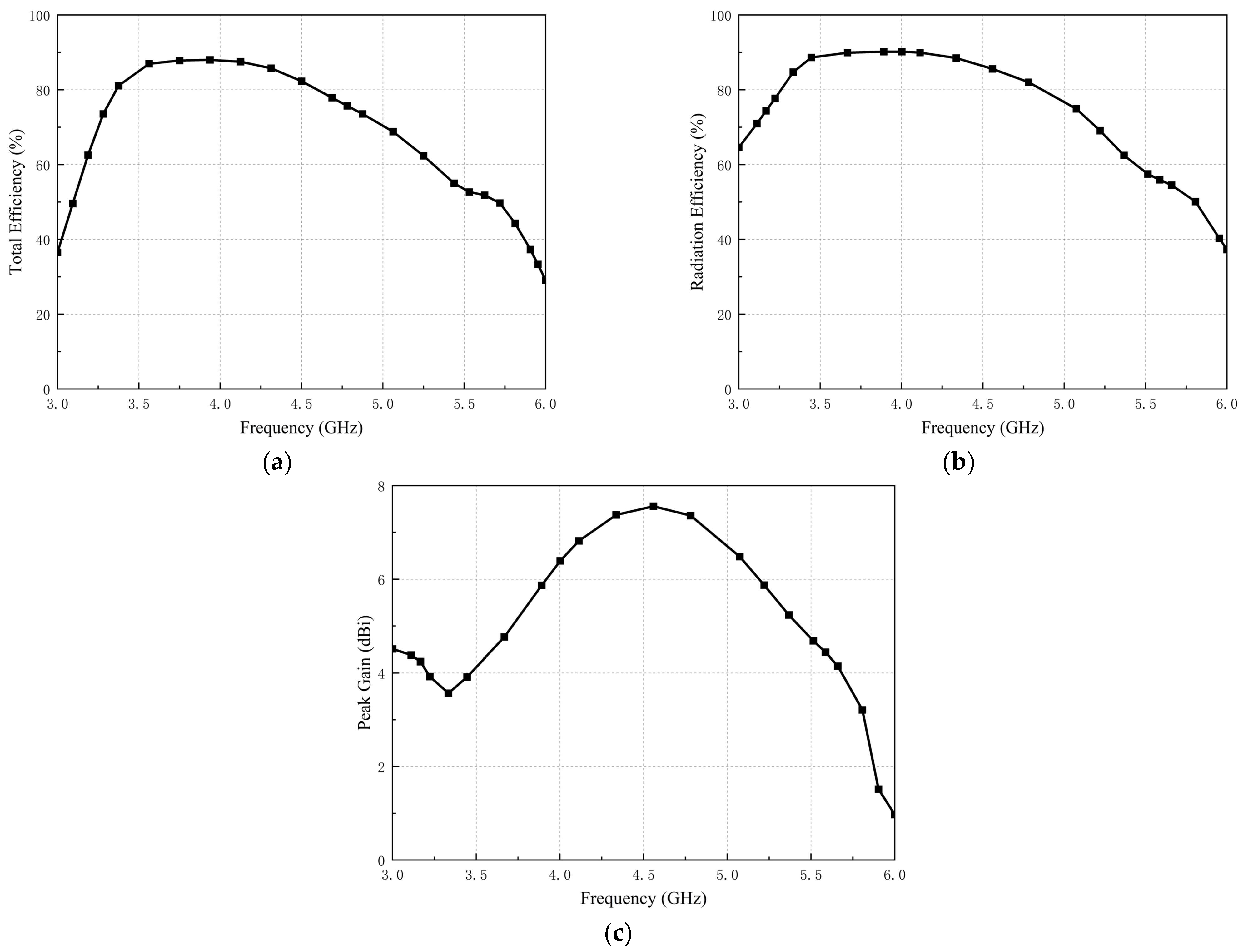
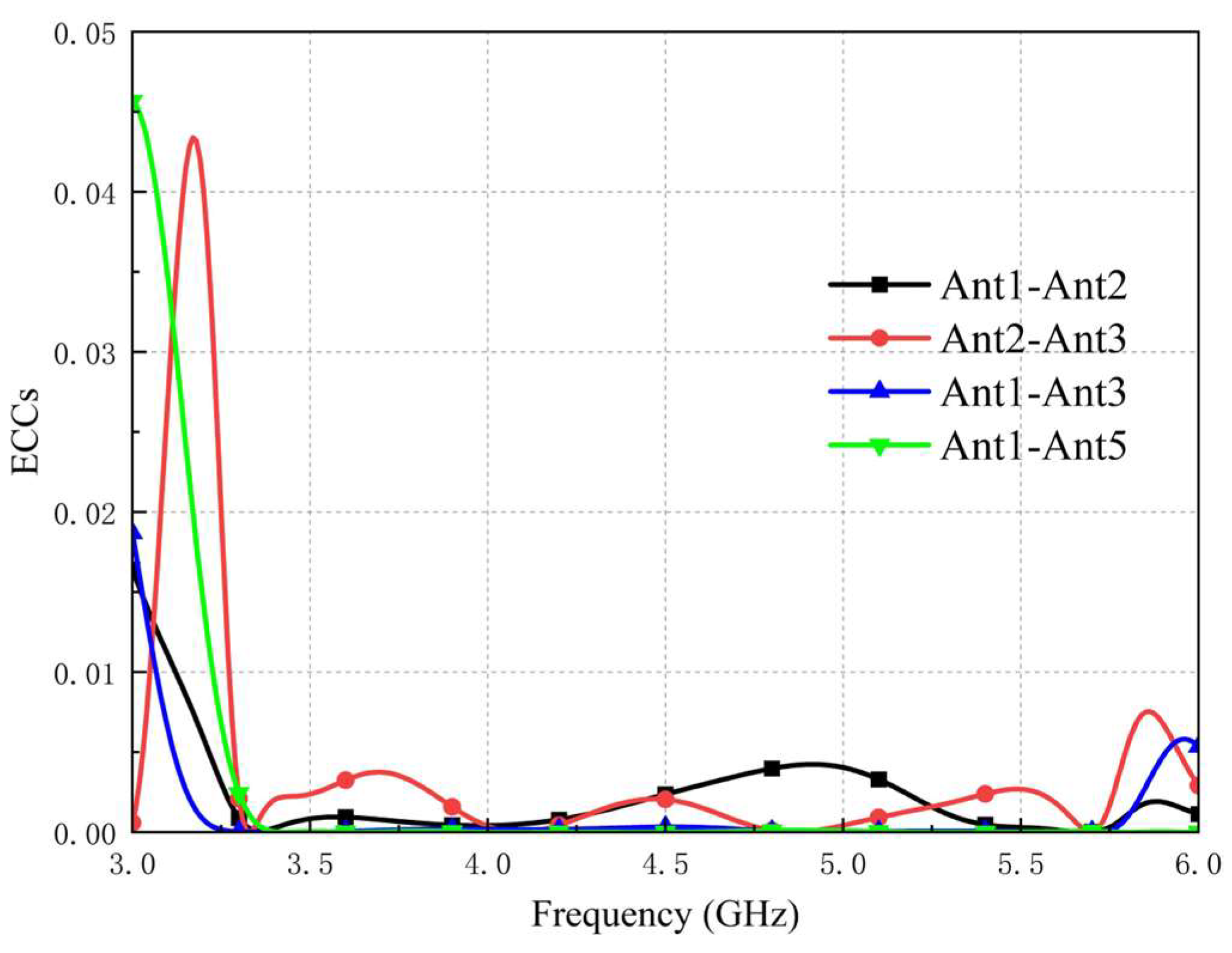


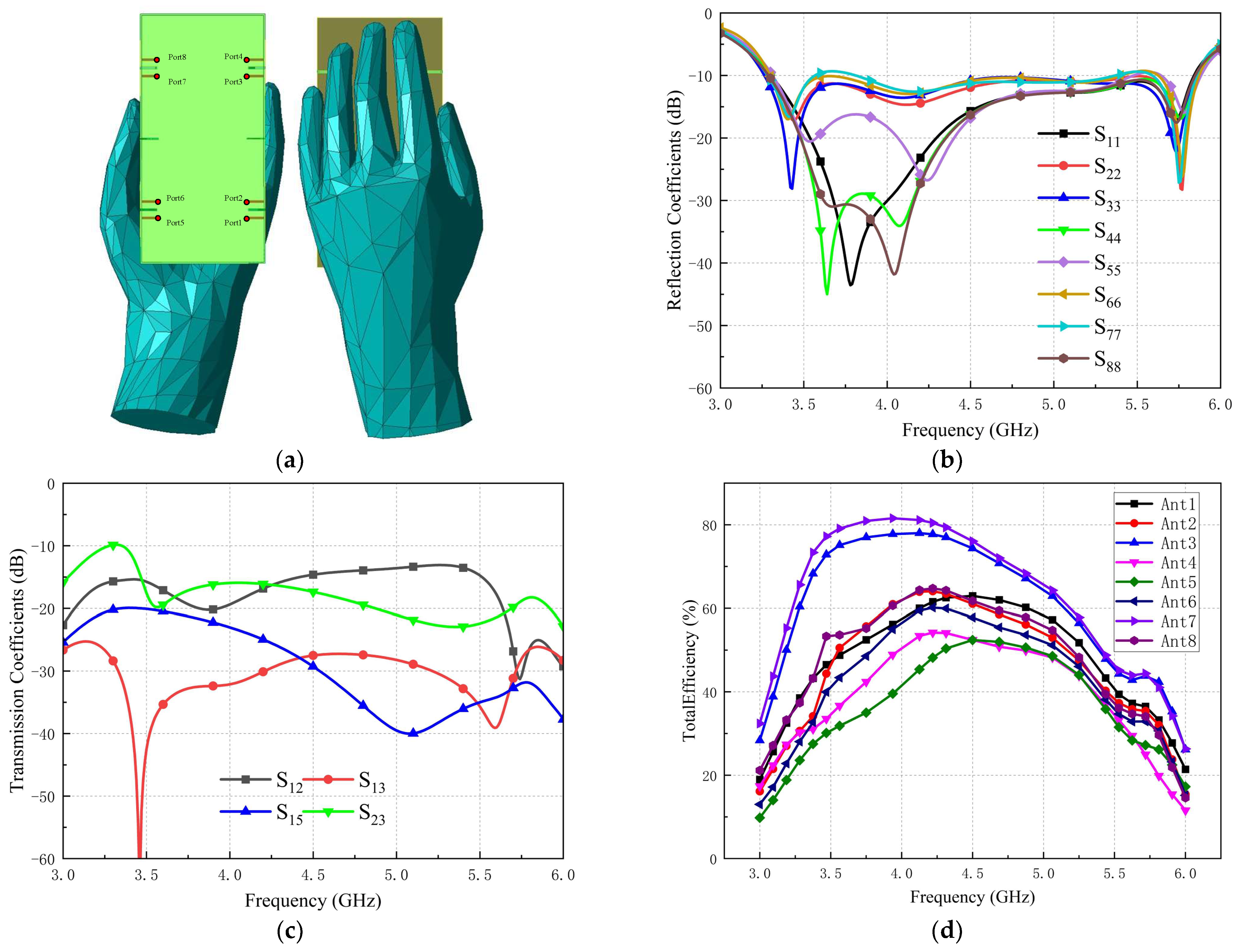
| Design | Antenna Pairs | Decoupling Methods | Element Size (mm2) | Frequency (GHz) | Isolation (dB) | Total Efficiency (%) | ECC |
|---|---|---|---|---|---|---|---|
| [20] | √ | Orthogonal mode | 40 × 7.5 | 3.3~5.0 GHz (−6 dB) | <−12 | 31.6–76.7 | <0.11 |
| [22] | √ | Neutralization lines | 35.7 × 5 | 3.1~3.85 GHz 4.8~6 GHz (−10 dB) | <−17 | 60–71 | <0.06 |
| [23] | - | Neutralization lines | 17.5 × 7.5 | 3.3–5.6 GHz (−6 dB) | <−15 | 45–80 | <0.03 |
| [27] | √ | Parasitic elements and DGS | 37 × 6 | 3.3–5.95 GHz (−6 dB) | <−15 | 47–78 | <0.11 |
| [29] | √ | DGS | 28 × 6 | 3.23–5.24 (−10 dB) | <−11 | 50–89 | <0.04 |
| [30] | - | DGS | 22 × 2 | 3.3–6 GHz (−6 dB) | <−12.1 | 50–61 | <0.2 |
| Proposed | √ | Parasitic elements and DGS | 33.6 × 6 | 3.28–5.85 GHz (−10 dB) | <−12.42 | 50–88 | <0.01 |
Disclaimer/Publisher’s Note: The statements, opinions and data contained in all publications are solely those of the individual author(s) and contributor(s) and not of MDPI and/or the editor(s). MDPI and/or the editor(s) disclaim responsibility for any injury to people or property resulting from any ideas, methods, instructions or products referred to in the content. |
© 2023 by the authors. Licensee MDPI, Basel, Switzerland. This article is an open access article distributed under the terms and conditions of the Creative Commons Attribution (CC BY) license (https://creativecommons.org/licenses/by/4.0/).
Share and Cite
Liu, Z.; Wang, Y.; Hu, Y.; Zhang, L. Design of Wideband Decoupling Antenna Array for 5G Smartphones at N77/N78/N79/WLAN 5 GHz Bands. Appl. Sci. 2023, 13, 9370. https://doi.org/10.3390/app13169370
Liu Z, Wang Y, Hu Y, Zhang L. Design of Wideband Decoupling Antenna Array for 5G Smartphones at N77/N78/N79/WLAN 5 GHz Bands. Applied Sciences. 2023; 13(16):9370. https://doi.org/10.3390/app13169370
Chicago/Turabian StyleLiu, Zhao, Yongshun Wang, Yao Hu, and Lijun Zhang. 2023. "Design of Wideband Decoupling Antenna Array for 5G Smartphones at N77/N78/N79/WLAN 5 GHz Bands" Applied Sciences 13, no. 16: 9370. https://doi.org/10.3390/app13169370





